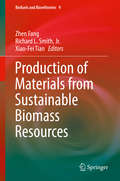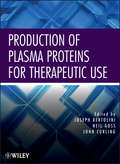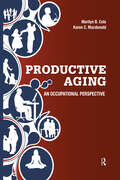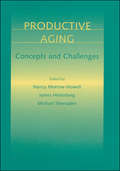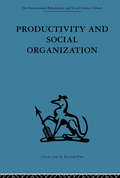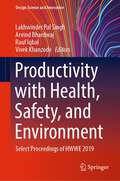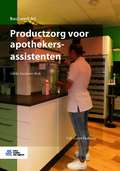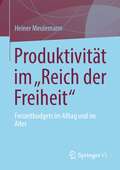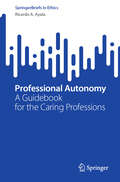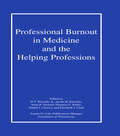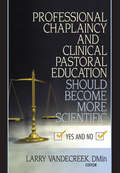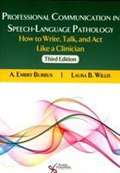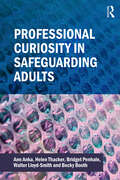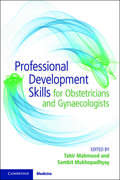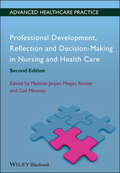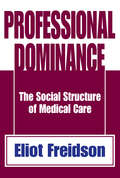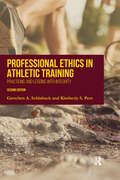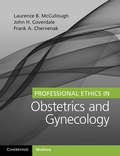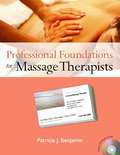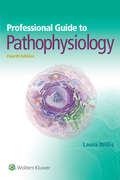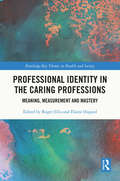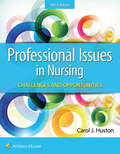- Table View
- List View
Production of Materials from Sustainable Biomass Resources (Biofuels and Biorefineries #9)
by Zhen Fang Richard L. Smith Jr Xiao-Fei TianThis book presents a collection of studies on state-of-art techniques developed specifically for lignocellulose component derivation, and for the production of functional materials, composite polymers, carbonaceous biocatalysts, and pellets from lignocellulosic biomass, with an emphasis on using sustainable chemistry and engineering to develop innovative materials and fuels for practical application. Technological strategies for the physical processing or biological conversion of biomass for material production are also presented. All chapters were contributed by respected experts in the field from around the globe, providing a broad range of perspectives on cutting-edge applications.The book offers an ideal reference guide for academic researchers and industrial engineers in the fields of natural renewable materials, biorefinery of lignocellulose, biofuels and environmental engineering. It can also be used as a comprehensive reference source for university students in chemical engineering, material science and environmental engineering.
Production of Plasma Proteins for Therapeutic Use
by Neil Goss John Curling Joseph BertoliniSets forth the state of the science and technology in plasma protein production With contributions from an international team of eighty leading experts and pioneers in the field, Production of Plasma Proteins for Therapeutic Use presents a comprehensive overview of the current state of knowledge about the function, use, and production of blood plasma proteins. In addition to details of the operational requirements for the production of plasma derivatives, the book describes the biology, development, research, manufacture, and clinical indications of essentially all plasma proteins with established clinical use or therapeutic potential. Production of Plasma Proteins for Therapeutic Use covers the key aspects of the plasma fractionation industry in five sections: Section 1: Introduction to Plasma Fractionation initially describes the history of transfusion and then covers the emergence of plasma collection and fractionation from its earliest days to the present time, with the commercial and not-for-profit sectors developing into a multi-billion dollar industry. Section 2: Plasma Proteins for Therapeutic Use contains 24 chapters dedicated to specific plasma proteins, including coagulation factors, albumin, immunoglobulin, and a comprehensive range of other plasma-derived proteins with therapeutic indications. Each chapter discusses the physiology, biochemistry, mechanism of action, and manufacture of each plasma protein including viral safety issues and clinical uses. Section 3: Pathogen Safety of Plasma Products examines issues and procedures for enhancing viral safety and reducing the risk of transmissible spongiform encephalopathy transmission. Section 4: The Pharmaceutical Environment Applied to Plasma Fractionation details the requirements and activities associated with plasma collection, quality assurance, compliance with regulatory requirements, provision of medical affairs support, and the manufacture of plasma products. Section 5: The Market for Plasma Products and the Economics of Fractionation reviews the commercial environment and economics of the plasma fractionation industry including future trends, highlighting regions such as Asia, which have the potential to exert a major influence on the plasma fractionation industry in the twenty-first century.
Productive Aging: An Occupational Perspective
by Marilyn B. Cole Karen Crane MacdonaldProductive Aging: An Occupational Perspective is a concise and practical text that takes a fresh look at our rapidly expanding and diverse older population. Recognizing the unique identity of each older person, this text provides client-centered guidelines for maximizing function, independence, and wellness. Productive Aging also outlines self-management strategies for promoting participation and engagement in productive occupations for the older persons’ own continuing development, health, and well-being.Productive Aging not only summarizes current evidence, but it looks into the lives of forty productive agers who shared their personal perspective with the authors as part of an original qualitative study. These participant stories, often told in the participants own words, describe how current theories of aging are applied in the lives of older adults who are currently living the experience. Older adults ages 60 to 98 describe the effective strategies they used to manage their own aging process, to structure healthy lifestyles and social connections, and to intentionally direct their own productive occupations in satisfying and meaningful ways. The results of this qualitative research study have led to a grounded theory of Conditional Independence, which guides occupational therapy approaches to productive aging in practice. Authors Marilyn B. Cole and Dr. Karen C. Macdonald explore the six productive occupations that researchers have identified as typical of older adults today: self-management, home management, volunteering, paid work, care giving, and lifelong learning. In addition to summarizing current research and theories within each occupation, concrete strategies and techniques relative to these roles are detailed, with multiple examples, case studies, and learning activities. Throughout Productive Aging, interviews with experienced practitioners, administrators, and educators reveal some of the implications of various trends and techniques. For occupational therapists, descriptions of settings and types of intervention are consistent with the latest version of AOTA’s Occupational Therapy Practice Framework, Third Edition. In addition to promoting productive occupations within traditional institutional and medical-based practice, occupational therapy roles include that of consultant, educator, and advocate when treating individuals, groups, and populations in home care, organizational, and community settings. Special attention is given to developing the ability to become an effective self-manager, facilitating social participation, and maximizing clients’ applied functional abilities.Productive Aging: An Occupational Perspective is the perfect addition to the bookshelf of occupational therapy students, faculty, and clinicians, as well as any health care practitioner who would like to update his or her knowledge of the aging individual within his or her current practice settings.
Productive Aging: Concepts and Challenges (Gerontology)
by Michael Sherraden Nancy Morrow-Howell James Hinterlong"Will 69 million baby boomers suddenly drop out of the workforce when they turn 65? It is difficult to imagine this generation, with its talent, education, and experience, idling away the last thirty years of life."—From the Foreword, by Robert N. Butler, M.D., The Mount Sinai Medical CenterOld age has been historically thought of as a period of frailty and dependence, yet studies show that with the help of advances in health and medicine, current populations will live longer and remain healthier than previous generations. As average life expectancies rise, traditional concepts of retirement need to be reconsidered on all levels—from government policy to business practice to individual life planning. In this volume, leaders in the field of gerontology explore these changing conditions through the concept of "productive aging," which has been developed by leaders in the field to promote older adults' contributions to society in social and economic capacities.Productive Aging: Concepts and Challenges treats the implications of productive aging for the discipline of gerontology and for society in general. The first section defines the principles, historical perspectives, and conceptual frameworks for productive aging. The second section takes a disciplinary approach, treating the biomedical, psychological, sociological, and economic implications of a more capable older generation. The third section considers advances in theories of gerontology, and the fourth section suggests future directions in practice, theory, and research. Contributors: W. Andrew Achenbaum, University of Houston • Scott A. Bass, University of Maryland-Baltimore • Vern L. Bengtson, University of Southern California • James E. Birren, UCLA • Francis G. Caro, University of Massachusetts Boston • Carroll L. Estes, University of California-San Francisco • Marc Freedman, Civic Ventures (co-founder of Experience Corps) • James Hinterlong, Washington University • James S. Jackson, University of Michigan • Jane L. Mahakian, Pacific Senior Services • Harry R. Moody, Robert Wood Johnson Foundation • Nancy Morrow-Howell, Washington University • Philip Rozario, Washington University • James H. Schulz, Brandeis University • Michael Sherraden, Washington University • Alvar Svanborg, University of Illinois-Chicago and Goteburg University, Sweden • Brent A. Taylor, San Diego State University
Productivity and Social Organization: The Ahmedabad experiment: technical innovation, work organization and management
by A. K. RiceTavistock Press was established as a co-operative venture between the Tavistock Institute and Routledge & Kegan Paul (RKP) in the 1950s to produce a series of major contributions across the social sciences. This volume is part of a 2001 reissue of a selection of those important works which have since gone out of print, or are difficult to locate. Published by Routledge, 112 volumes in total are being brought together under the name The International Behavioural and Social Sciences Library: Classics from the Tavistock Press. Reproduced here in facsimile, this volume was originally published in 1958 and is available individually. The collection is also available in a number of themed mini-sets of between 5 and 13 volumes, or as a complete collection.
Productivity with Health, Safety, and Environment: Select Proceedings of HWWE 2019 (Design Science and Innovation)
by Rauf Iqbal Vivek Khanzode Arvind Bhardwaj Lakhwinder Pal SinghThis volume comprises select proceedings of the International Conference on Humanizing Work and Work Environment organized by the Indian Society of Ergonomics (HWWE2019). The book presents research findings on different areas of ergonomics for developing appropriate tools and work environment considering capabilities and limitations of working people for maximum effectiveness on their performance. This volume will be of interest to academics, professionals and practitioners in the field of ergonomics.
Productzorg voor apothekersassistenten (Basiswerk AG)
by Y.M. Groot-PadbergDit boek gaat over het beschikbaar stellen van geneesmiddelen en zelfzorgmiddelen, voorraadbeheer en logistiek. Daarbij houdt de apothekersassistent rekening met de behoeften van de patiënt, de houdbaarheid en de leveringstijd van middelen. Met theoretische kennis over het bereiden van verschillende toedieningsvormen gaat de apothekersassistent na of het geneesmiddel kan worden klaargemaakt of bereid. De apothekersassistent past daarbij richtlijnen, protocollen en vaststaande procedures toe.Dit boek sluit naadloos aan op kerntaak 3 (Biedt productzorg) van het Kwalificatiedossier mbo Apothekersassistent. Met dit boek krijgen studenten theoretische basiskennis over verschillende toedieningsvormen, zodat zij zelfstandig producten kunnen afleveren en correcte productinformatie kunnen geven. Verdiepende kennis over het bereiden van geneesmiddelen is ondergebracht in Bereiden en aseptisch handelen (1e druk), een nieuw boek in de reeks Basiswerk AG.Productzorg voor apothekersassistenten (5e druk) is onmisbaar als basisboek voor de opleiding tot apothekersassistent. Ook kan het boek uitstekend als naslagwerk in de praktijk worden gebruikt.Yvonne Groot-Padberg studeerde farmacie in Amsterdam. Na het behalen van het apothekersdiploma in 1988 is zij werkzaam geweest in de farmaceutische industrie als productontwikkelaar en farmaceutisch projectleider. Sinds 2002 is zij werkzaam in het mbo-onderwijs, waar zij naast haar werk als teamleider lessen in productzorg verzorgt.
Produktivität im „Reich der Freiheit“: Freizeitbudgets im Alltag und im Alter
by Heiner MeulemannGewinnen mit der wachsenden Freizeit produktive auf Kosten konsumtiver Aktivitäten? Zeitbudgetbefragungen zeigen, wie sich mit der wachsenden Freizeit die Verteilung der Freizeit auf produktive und konsumtive Aktivitäten verändert – sowohl in der täglichen Freizeit aller wie mit dem Freizeitgewinn durch Alter und Ruhestand. Im Zeitbudget der gesamten deutschen Bevölkerung zwischen 2001 und 2012 und im Vergleich der Altersgruppen unter und über 65 Jahren wachsen produktive Freizeitaktivitäten nicht auf Kosten konsumtiver an, wohl aber im Vergleich von Erwerbstätigen und Rentnern.
Professional Autonomy: A Guidebook for the Caring Professions (SpringerBriefs in Ethics)
by Ricardo A. AyalaAimed at supporting their emancipatory project, this book explores strategies for resisting dominance and enhancing agency within the caring professions. It helps bridge the gap between theoretical and practical autonomy in these fields, which have long been overshadowed by other professional groups. The book scrutinises the often-misunderstood notion of autonomy, which is frequently equated with mere independence—an equation that can paradoxically undermine, rather than improve, care quality. Additionally, it critiques the prevailing lack of a specific philosophical framework for practice. Existing literature typically approaches professional autonomy through a liberal philosophy lens or loosely assigns moral agency to groups, leading to a view of autonomous professions as analogous to autonomous individuals. By presenting a critical overview of the main schools of thought on autonomy—emphasising group autonomy and the specific challenges faced by caring professions—this book aims to fill a significant gap. It includes case studies to ground its theoretical insights in practical examples from real-world scenarios, helping the caring professions identify both autonomy issues and opportunities for enhancing autonomous practice.
Professional Burnout in Medicine and the Helping Professions
by Jr. Austin H. Kutscher Elizabeth J. Clark Florence E. Selder D. T. Wessells Irene B. Seeland Daniel J. ChericoPhysicians and other helping professionals have created a practical, hands-on book that will aid in the identification and reduction of job stress. Nurses, physicians, thanatologists, and psychotherapists are among the growing number of health care professionals whose physical and mental health are being severely affected by work stress. This unique volume achieves what no earlier book has attempted for this specialized professional group. It offers a thorough understanding of professional burnout, elaborating how burnout develops and offering a model with which to identify job stressors. Professional Burnout in Medicine and the Helping Professions also offers an in-depth exploration of stress and burnout issues from the perspectives of specific medical and helping profession disciplines--physicians, nurses, social workers, psychotherapists, teachers, consultants, agency and hospital workers, funeral directors, and more.Experts in these fields examine the values, ethics, and morality of individuals, health care organizations, and society that may lead to burnout This in-depth and highly practical volume identifies the stages of disillusionment and offers successful intervention strategies for recognizing the signs and reducing or efficiently managing causative factors.
Professional Chaplaincy and Clinical Pastoral Education Should Become More Scientific: Yes and No
by Larry Van De CreekDoes the scientific process belong in pastoral counseling? Professional Chaplaincy and Clinical Pastoral Education Should Become More Scientific: Yes and No examines the widespread ambivalence among pastoral caregivers and educators over the growing inclusion of science in pastoral care and counseling methodologies. Twenty-three seasoned professionals in the field give candid and sometimes emotional accounts of their interest in-and reservations about-the role scientific research plays in their profession. Some authors look at the issue from a historical perspective; others voice additional concerns. A few make concrete proposals on how chaplaincy can become more scientific. The result is a unique insight into the relationship between the secular and the religious. The question of whether science belongs in pastoral care and counseling is moot; pastoral care already makes extensive use of psychological testing and psychotherapeutic skills-all products of scientific thinking. But as technology becomes more dominant and health care delivery reflects a more corporate perspective, pastoral caregivers and educators are divided on whether the changes represent the significant opportunity to improve a ministry or the surrender of the ministry&’s very essence. The essays collected in Professional Chaplaincy and Clinical Pastoral Education Should Become More Scientific: Yes and No go a step farther, breaking down the issue of faith versus science into more specific questions for pastoral caregivers, such as: Can what you do be measured? Do you have an obligation to embrace the challenge of change? Is becoming more scientific a necessity for staying in touch with your health care peers? How cost effective is the pastoral care you provide if it doesn&’t include the scientific process? Could a reluctance to incorporate science into your counseling cost you your job? Professional Chaplaincy and Clinical Pastoral Education Should Become More Scientific: Yes and No presents thoughtful and thought-provoking debate that is a must-read for all pastoral caregivers and educators.
Professional Communication In Speech-Language Pathology: How To Write, Talk, And Act Like A Clinician
by Laura Willis A. BurrusIn Professional Communication in Speech-Language Pathology: How to Write, Talk, and Act Like a Clinician, Third Edition, the authors introduce student clinicians to the various types of written and verbal communication they will encounter across three different clinical settings: university clinics, medical settings, and public schools. The text is written in a student-friendly manner, with appendices that provide examples of correspondence, diagnostic and treatment reports, data sheets, and important acronyms in medical and school settings. Chapters cover verbal interactions with families, allied professionals, and supervisors, as well as written communication across the university, medical, and school settings. Also included are scenarios written in the form of vignettes that address issues of ethics, interviewing, and procedures for managing protected health information.
Professional Curiosity in Safeguarding Adults
by Bridget Penhale Ann Anka Helen Thacker Walter Lloyd-Smith Becky BoothThis is an essential text for students at all levels studying social work, nursing and allied health and social care, focusing on the need for professional curiosity and partnership work in safeguarding adults. Professional curiosity is a vital element of professional health and social care practice, yet information and guidance are scarce. Considering the post-pandemic landscape and the legal policy context of partnership work, this text provides a detailed examination around definitions of professional curiosity and what those mean in practice in relation to vulnerable adults. Real life examples are woven throughout based on serious case reviews, safeguarding adults’ reviews, domestic homicide reviews and extensive research, and there are numerous opportunities for readers to test their knowledge and skills.
Professional Development Skills for Obstetricians and Gynaecologists
by Tahir Mahmood Sambit MukhopadhyayProfessional development skills encompass non-clinical attributes that contribute towards career development, research and high-quality clinical practice. Professional bodies such as the Royal College of Obstetrics and Gynaecology (RCOG) are placing increasing importance on these skills and they now form part of the RCOG core curriculum, making these skills essential requirements for all junior doctors and newly appointed consultants in today's health service. This book is an in-depth review of professional development skills, illustrated by case-histories from obstetrics and gynaecology. Issues related to human factors - such as communication, situational awareness, decision-making and team-working - will form the basis of the book. Candidates sitting the Membership of the Royal College of Obstetrics and Gynaecology (MRCOG) examination will gain a better understanding of the principles of professionalism and clinical governance within the specialty. This book is also a useful tool for trainees in their advanced years of training and for newly appointed consultants.
Professional Development, Reflection and Decision-Making in Nursing and Healthcare
by Megan Rosser Melanie Jasper Gail MooneyThis essential text brings together in one place the inextricably linked concepts of professional development, reflective practice and decision-making. Fully updated and revised throughout, the new edition of this easy-to-follow, jargon-free title is targeted at nursing and healthcare practitioners and nursing students, providing clear guidance to help the reader think critically about their practice, work within professional boundaries, be accountable for their actions, and plan for their future.
Professional Dominance: The Social Structure of Medical Care
by Eliot FreidsonIn the United States today we are confronted by a number of serious social problems, not the least of which concern the character of our basic human services. In each of the broad public domains of welfare, education, law, and health there are crises of public confidence. Each in its own way is failing to accomplish its essential mission of alleviating material deprivation, instructing the young, controlling and righting criminal and civil wrongs, and healing the sick. The poor, the student, the offender and the victim, the sick-all have in some way protested the failure of the institutions responsible for them. And these protests occur at a time when the human services are absorbing an increasingly massive amount of money and manpower. Awareness of that crisis intensified in the second half of the twentieth century. Increasing energy has been invested in research designed to determine what can be done. Each of the human services has long had its own research tradition, but during the sixties each has also made a concerted effort to mobilize and use the skills of such comparatively new disciplines as sociology. Owing to these new demands, sociology itself has grown. The hitherto obscure specialties of the sociology of law and medicine and the established specialties of criminology and educational sociology have taken on new vigor. In applying themselves the task of studying the human services, however, these segments of sociology have had to choose between two different strategies. Rather than dealing with the details of the human services for their own sake-and this lack of detail in a characteristic limitation of the second approach-this book shall instead attempt to stand outside the system in order to delineate one of its critical assumptions and a strategic feature of its basic structure. This book deals with the concept of profession, for the concept rests on assumptions about how services to laymen should be controlled and is realized by a special kind of
Professional Ethics and Primary Care Medicine: Beyond Dilemmas and Decorum
by Larry R. Churchill Harmon L. SmithThis volume moves beyond ethics as problem-solving or ethics as etiquette to offer a look at ethics in primary care--as opposed to life-or-death--medical care. Professional Ethics and Primary Care Medicine deals with the ethics of routine, day-to-day encounters between doctors and patients. It probes beneath the hard decisions to look at the moral frameworks, habits of thought, and customs of practice that underlie choices. Harmon Smith and Larry Churchill argue that primary care, far from being merely a setting for the rendering of care, provides a new understanding of both physician and patient, and thereby offers a fresh basis for medical ethics.
Professional Ethics in Athletic Training: Practicing and Leading With Integrity
by Gretchen Schlabach Kimberly PeerA comprehensive textbook for athletic training students, educators, and practitioners, Professional Ethics in Athletic Training: Practicing and Leading With Integrity, Second Edition provides a framework for understanding and applying ethical principles across the career span of an athletic training professional.Esteemed authors Gretchen A. Schlabach and Kimberly S. Peer explain the necessity of practicing and leading with integrity across one’s athletic training career. The text explores issues related to cultural competence and professional behavior as well as ethical leadership and decision-making skills that both inform and transcend the athletic training profession.Each chapter is accompanied by frameworks that lead to both analysis and awareness of legal statutes, ethical principles, regulatory practice acts, and professional practice standards that encourage responsible reasoning and conduct. Contemporary journal articles can also be found in every chapter to help readers make connections between content and clinical practice. The text also includes assessment tools, sample models for ethical decision making, writing about moral issues, and sample course design and delivery for teaching ethics. Included in the instructor’s materials are nearly 50 cases to promote critical thinking as well as learning activities for each chapter. Included with the text are online supplemental materials for faculty use in the classroom.Covering all levels of ethical practice—from the entry-level student to the experienced athletic trainer—Professional Ethics in Athletic Training synthesizes and integrates ethical theory and practical application for those who practice and lead with integrity.
Professional Ethics in Obstetrics and Gynecology
by Frank A. Chervenak Laurence B. McCullough John H. CoverdaleA comprehensive, accessible approach to the everyday ethical challenges faced in obstetric and gynecological practice. Offering practical guidance for practitioners at all levels, the text also provides a sustained exploration of professional ethics in the intersection of obstetrics and gynecology with psychiatry. Drawing on their award-winning teaching, the authors start each chapter with goals, objectives, topics, and a list of key concepts, which are defined in a separate section. Chapters cover a multitude of topics, from pregnancy and the quest for the 'perfect' baby to end-of-life care - all underpinned by the need for professionally responsible research, advocacy, and health policy. Professional Ethics in Obstetrics and Gynecology is an indispensable resource for both trainee and practicing obstetricians and gynecologists. A chapter devoted solely to pedagogy in professional ethics in obstetrics and gynecology supports the readers' learning and those with or without formal training in ethics to teach students, residents, and colleagues.
Professional Foundations for Massage Therapists
by Patricia J. BenjaminThis concise, practical instruction guide focuses on the broader picture of massage therapy as a meaningful career. It approaches massage therapy education as a holistic process acknowledging the need for developing personal as well as professional proficiencies.
Professional Governance for Nursing: The Framework for Accountability, Engagement, and Excellence
by Rachel E. Start Beverly J. Hancock Tim Porter-O'GradyNurses are professionally accountable to improve the health of patients and populations alike. Sustaining behavioral change is impossible unless structural change enables it. A common professional framework is needed in all practice settings to formalize the voice of nurse’s ownership and accountability for practice decision-making related to clinical problems and solutions, forming practice policy, and pursuing solutions affecting health outcomes and advancing the quality of healthcare. Published in partnership with AONL, Professional Governance for Nursing: The Framework for Accountability, Engagement, and Excellence expertly covers concepts, roles, application, and demonstration of professional governance that facilitates the nurse’s role in advancing the impact and value of nursing care across all health settings. This nursing book informs and deepens understanding of the centrality of nursing professional governance in addressing contemporary issues affecting nursing practice.
Professional Guide to Diseases
by Laura WillisGet ready to provide efficient, informed patient care, with the newly updated Professional Guide to Diseases , 11th Edition . This comprehensive guide offers the causes, signs and symptoms for more than 600 disorders, with expert nursing direction on tests, assessments, diagnosis, treatments, and special considerations. Whether you are a student preparing for board certification or are a new or experienced nurse, this is vital support for understanding correct treatment of the common conditions seen almost daily.
Professional Guide to Pathophysiology
by Laura WillisPublisher's Note: Products purchased from 3rd Party sellers are not guaranteed by the Publisher for quality, authenticity, or access to any online entitlements included with the product. Stressed and confused about pathophysiology? Time to develop your mastery: The newly updated Professional Guide to Pathophysiology, 4th Edition, is the go-to comprehensive guide that explains more than 400 disorders across all body systems — from causes, symptoms and diagnosis to treatment and special considerations. The ideal on-the-unit reference, certification exam review or backup to classroom materials, this is the expert-at-your-side support that both new and experienced nurses, and students at all levels of nursing study, cannot do without. Empower your pathophysiology knowledge with this foundational, irreplaceable reference: NEW content on both normal physiology and disease states Easy-to-follow, consistent template that makes finding vital information quick and easy — combines the best features of a disease reference with the best features of a full-color atlas Small keep-it-handy size that is ideal for on-the-spot reference Illustrations, algorithms, tables and text boxes such as Closer Look images and Prevention, Disease Block and Multisystem Disorder icons that clarify pathophysiological processes and anatomy, demonstrating difficult concepts Offers current top-level findings on: Foundational knowledge — normal cellular physiology, followed by the pathologic deviations of disease Cancer, infection, and fluid and electrolytes Genetics — cellular/DNA components and functions, as well as tests, treatments, and care considerations for genetic abnormalities Diseases and disorders particular to each body system — chapters organized by body system Less common disorders Disease entries thatoffer the pathophysiologic foundations and rationale behind focused assessments, offering causes, signs and symptoms, complications, diagnostic tests, treatment, and special considerations Chapter features that emphasize important concepts and differences among disorders and among patient populations, for accurate assessments and treatments: Genetic Link, Age Alert, Clinical Alert, Life-Threatening Disorder and Confirming Diagnosis Expert guidance and practical insights on providing effective care for both common and less common disorders Excellent reference for studies and research in pathology, pathophysiology, and physiology — helpful for creating nursing care plans Concise, detailed explanations of all major diseases — reinforces and clarifies classroom teachings Easy-to-read, easy-to-retain information that translates easily from student text to must-have professional reference, offering students and new nurses the self-assurance to offer high-level care
Professional Identity in the Caring Professions: Meaning, Measurement and Mastery (Routledge Key Themes in Health and Society)
by Roger Ellis Elaine HogardProfessional identity is a central topic in all courses of professional training and educators must decide what kind of identity they hope their students will develop, as well as think about how they can recruit for, facilitate and assess this development. This unique book explores professional identity in a group of caring professions, looking at definition, assessment, and teaching and learning. Professional Identity in the Caring Professions includes overviews of professional identity in nursing, medicine, social work, teaching, and lecturing, along with a further chapter on identity in emergent professions in healthcare. Additional chapters look at innovative approaches to selection, competency development, professional values, leadership potential and reflection as a key element in professional and interprofessional identity. The book ends with guidance for curriculum development in professional education and training, and the assessment of professional identity. This international collection is essential reading for those who plan, deliver and evaluate programs of professional training, as well as scholars and advanced students researching identity in the caring professions, including medicine, nursing, allied health, social work and teaching.
Professional Issues in Nursing: Challenges and Opportunities
by Carol HustonPublisher's Note: Products purchased from 3rd Party sellers are not guaranteed by the Publisher for quality, authenticity, or access to any online entitlements included with the product. Professional Issues in Nursing: Challenges and Opportunities, 5th Edition Carol J. Huston, RN, MSN, MPA, DPA, FAAN Prepare for the realities of today’s nursing practice. Gain a professional edge in the nursing workplace with expert insight across a variety of contemporary and enduring issues you’ll encounter on the job. Comprehensively updated and reflecting the latest evidence-based perspectives, Professional Issues in Nursing: Challenges and Opportunities, 5th Edition, prepares you to confidently manage timely workplace considerations, workforce issues, legal and ethical concerns, nursing education challenges, and issues related to professional power and furthering the nursing profession. New! Chapters on healthcare reform and the ethical issues associated with emerging technologies equip you for today’s ever-changing nursing practice. Updated! Workplace Violence chapter helps you ensure civility and a healthy workplace environment. Updated! Cutting-edge content throughout the text familiarizes you with emerging trends in healthcare and nursing education. New! Full-color design makes challenging content approachable and engaging. Discussion Points encourage critical reflection for individual study or group discussions. Consider This features challenge you to form your own assessments of important practice considerations. Research Fuels the Controversy profiles reinforce your analytical capabilities with current, evidence-based research. Conclusions focus your retention on the most important chapter content. For Additional Discussion topics facilitate valuable group review opportunities.
